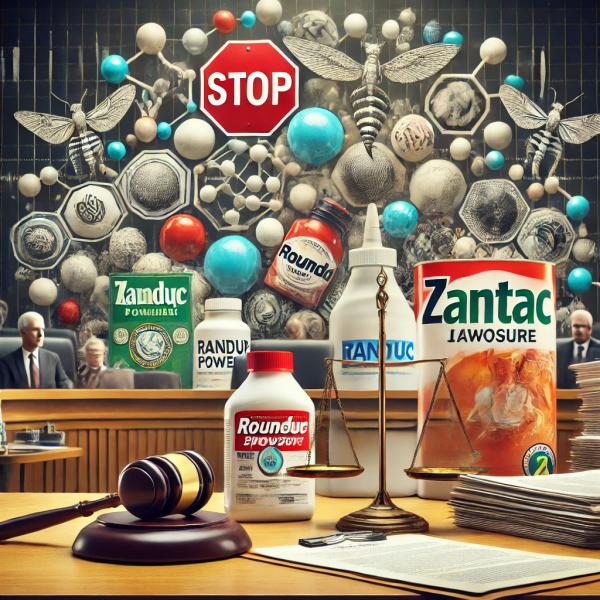
Note: These are intermediate findings, and final decisions are yet to come. For the moment, things bode well for the defense.
“Meso” [sic] is not a Japanese Soup
Mesothelioma, a cancer of the lining of the lungs and abdomen, had been crafted as a pathognomonic cancer of asbestos exposure by the plaintiffs’ sainted [now deceased] expert, Dr. Irving Selikoff. That means that merely making the diagnosis was tantamount to proving asbestos exposure. In recent years, that conclusion has been rebuffed, and it is now accepted that other factors and unknown exposures can be causal. This requires that plaintiffs must prove adequate exposure (dose) to a specific asbestos product to prevail.
In the Oregon case, the court held that the plaintiff’s claim of exposure to J&J’s talc powder was insufficient and that the mesothelioma diagnosis, by itself, was not determinative of the requisite exposure from J&J’s talc. This might impact a similar case now on trial in Connecticut. We should expect a written decision from the Oregon court shortly detailing the basis for the decision. The plaintiffs say they will appeal the Oregon decision, but without anything in writing yet, it’s difficult to predict their success. Currently, 57,937 talc powder lawsuits have been filed, an increase of 155 cases compared to last month. Should the Connecticut case go south, we can expect these cases to level off.
The Saga of Stomach Acid and Zantac-Land
Acid stomach is enough to sour any conversation, and the condition itself might mask or manifest some undetected ailment, such as cancer. In the meantime, doctors often recommended an antacid drug, such as Zantac, at least until it was voluntarily removed from the market two years ago. Upon creation of arguably fluffed (and invalid) evidence that high temperatures (the likes of the surface on Mars at 260 degrees Fahrenheit) can cause the drug to degrade into a known carcinogen came a host of lawsuits and a “Zantac-land” for the plaintiffs’ bar.
In Zantac-land, once the darling of the plaintiffs’ bar, things aren’t getting better for the plaintiffs. True, one manufacturer, Sanofi, is settling 4000 Zantac claims pending outside of Delaware. However, the Delaware lower court’s ruling (regarding some 75,000 cases), which accepted scientific findings adverse to Zantac manufacturers, is on appeal to the State’s highest court. Three Zantac cases have recently gone to trial in Illinois. Even in cases where the plaintiffs' experts were allowed to testify, the jury rejected their testimony: two cases ended in verdicts for the defense, and one ended with a hung jury. In August, a second Florida Court rejected plaintiffs’ experts and tossed the case. This one is in state court. Here’s what the plaintiffs’ bar had to say:
“Thankfully, there are 49 other states.” - Plaintiffs Lawsuit Information Center
This has not stopped plaintiffs from plowing forward; another case is pending in Connecticut. But there is genuine concern, as seen on the plaintiffs’ website:
“Florida is apparently an inhospitable venue for Zantac lawsuits.... We still believe there is sound science behind the Zantac cancer risk. However, if the defendant manufacturers are successful in their [Delaware] appeal …. [which] “Zantac attorneys are anxiously awaiting …, [This] will likely control the fate of all Zantac cases.”
RoundUp on RoundUp
Monsanto (Bayer) just won its second RoundUp case in Philadelphia (its 14th favorable verdict out of 20). Last week, a Missouri court upheld another Monsanto victory, and a third trial win was recently notched in Arkansas. A sixth Philadelphia case will start shortly, while about 54,000 cases remain. Interestingly, in the latest Philadelphia win, the jury concluded that the product was defective and that Monsanto failed to warn of known dangers. However, they also concluded that the exposure was not causal to the plaintiff’s non-Hodgkins lymphoma.
Globally, Bayer is focusing on securing a favorable ruling by the U.S. Supreme Court on the federal pre-emption question, which could largely end the RoundUp litigation. As far as Bayer is concerned, from the scientific point of view, out of the 16 epidemiological studies, there is no consistent or reliable proof that RoundUp causes cancer.
From a legal standpoint,
“The main question … is whether state-based failure-to-warn claims are preempted by federal law, since the EPA concluded glyphosate does not cause cancer and approved the Roundup™ label without a warning. “ - Bayer Global
With the discord between the recent Third Circuit ruling approving pre-emption and the Ninth and Eleventh Circuits disapproving, the issue is well on its way to Supreme Court review and reconciliation.
As I wrote, the Australia case ended in favor of the defense, with the judge rejecting a host of plaintiff's medical/scientific experts who proffered every conceivable mechanical, genetic, and toxicologic reason to prove that RoundUp causes cancer. The plaintiffs’ lawyers have not given up hope that things will turn around, although how remains a mystery.
Up and Coming
Several cases are currently in the works, the key ones involving formaldehyde-containing hair straighteners and the exposure to allegedly toxic chemicals at Camp LeJeune in North Carolina. Those cases are too early in their proceedings to assess the scientific strength behind them. The third toxic tort prevalent on the event horizon is over 25,000,000 hernia mesh lawsuits alleging that the mesh devices of two companies were defective, resulting in injuries and complications in patients undergoing hernia surgery. An initial $4.8 million in Rhode Island state court against mesh manufacturer CR Bard and an earlier $500,000 verdict in Stinson v. Davol, Inc. incentivize lawyers to seek another landmark verdict, which they believe will impact settlement payouts in hernia mesh litigation.



